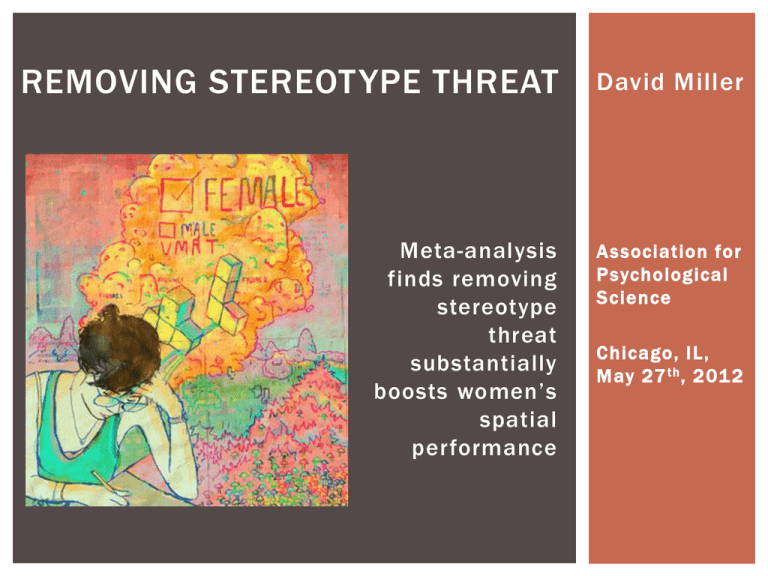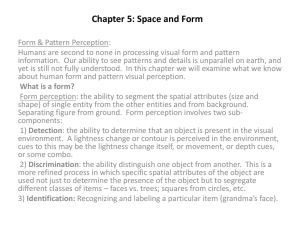Removing stereotype threat substantially boosts women`s spatial
advertisement

REMOVING STEREOTYPE THREAT David Miller Meta-analysis finds removing stereotype threat substantially boosts women’s spatial performance Association for Psychological Science Chicago, IL, May 27 th , 201 2 SPATIAL STEREOT YPES? Google “women driving” Google “men driving” SPATIAL GENDER DIFFERENCES Samples in the US and Germany perceived men as better at “imaging abstract objects and rotating them mentally in all directions” (Halpern et al., 2011; Haussmann et al., 2009) Mental rotation Gender d = 0.67 (Voyer et al., 1995) Spatial perception Gender d = 0.57 (Collaer et al., 2007) STEREOT YPE THREAT Stereotypes can harm academic performance (e.g., Steele & Aronson, 1995) Stereotype threat (ST) = concern about confirming a negative stereotype about one’s social group (e.g., gender) But why focus on the spatial domain? (many studies here) (not as many; they are more recent) INTEREST FOR SPATIAL THINKING Understand spatial gender differences Perhaps not most important question Change spatial gender differences (e.g., Miyake et al., 2010) Wai et al. (2009) found that 45% of all STEM PhDs were within the top 4% of spatial skills in high school Training spatial skills -> improved STEM achievement (Miller & Halpern, in press; Sorby, 2009) INTEREST FOR SOCIAL PSYCHOLOGY Role of working memory (confirmatory stage) (e.g., Beilock et al., 2007) Recruits verbal strategies Recruits spatial strategies ST activation impaired female per formance No ST activation ef fect Role of gender beliefs (exploratory stage) Navigation S Math S General Spatial S ? ? ? How ? Mental rotation gender belief Spatial ST CURRENT META -ANALYSIS ST removal ST activation Practical: ST removal is most important to education Theoretical: ST activation could introduce new ef fects not found in diagnostic control conditions Empirical: ST activation ef fects did not show consistent ef fects METHOD Search literature databases (e.g., PsycINFO, Google Scholar, PROQUEST) and examine each article’s reference list Example Description Moe & Pazzaglia (2006) Refute stereotype This test measures spatial abilities. Research showed that men perform better than women in this test This test measures spatial abilities. Research showed that spatial ability is very important in everyday life Huguet & Regner (2007) Make stereotype irrelevant; diagnostic manipulation This test measures your ability in drawing This test measures your ability in geometry List three reasons why one might attend a private liberal arts college List three reasons why one might prefer living in the Northeast to other parts of the U.S. McGlone & Prime a positive Aronson stereotype (2006) Exp. condition Control condition Walton and Cohen (2003) argued “refute stereotype” and “make stereotype irrelevant” are conceptually similar INCLUDED STUDIES Study N Participants Spatial Measure Brownlow et al. (2011) 96 US college students Mental rotation Campbell & Collaer (2009) 124 US college students Spatial perception Fancher (2008) 32 US college students Mental rotation & spatial perception Huguet & Regner (2007), study 1 40 French high school students Spatial memory Huguet & Regner (2007), study 2 454 French high school students Spatial memory Huguet & Regner (2009) 199 French high school students Spatial memory Martens et al. (2006) 105 US college students Mental rotation Moe (2009) 108 Italian high school students Mental rotation McGlone & Aronson (2006) 60 US college students Mental rotation Moe & Pazzaglia (2006) 134 Italian high school students Mental rotation Titze et al. (2010) 168 German children Mental rotation Wraga et al. (2006) 50 US college students Perspective taking Wraga et al. (2007) 30 US college students Perspective taking TOTAL 1,600 RESULTS A ggregate d = 0.52 0.8 Stereotype refuted or made irrelevant Positive identity intervention Effect Size (d) 0.6 d = 0.30 0.4 Only 3 studies!! 0.2 0 -0.2 -0.4 d = -0.27 Men Women Effect Comparison effect sizes: d Reference ST Removal - Women 0.52 Here Spatial Training 0.47 Gender & Mental Rotation 0.67 Voyer et al., 1995 Uttal et al., in press BROADER IMPLICATIONS LIMITATIONS & FUTURE RESEARCH Limitations Publication bias Longevity of effects Application to field contexts Assessments themselves (Miyake et al., 2010, Science) Recommendations for future research Focus on threat removal, not activation More research needed on positive-identity interventions Investigate role of spatial working memory and gender beliefs Apply to field settings and determine longitudinal effects






